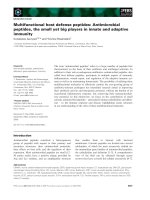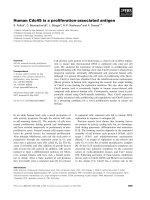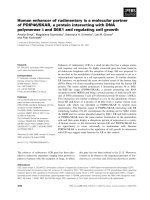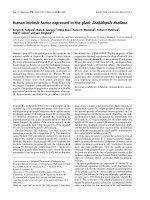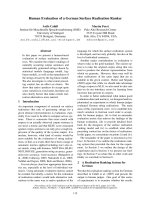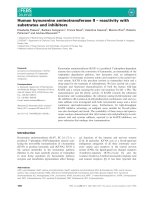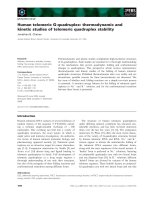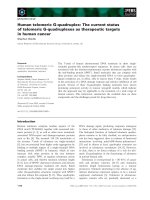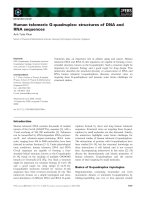Báo cáo khoa học: "Human vascular adhesion proteın-1 (VAP-1): Serum levels for hepatocellular carcinoma in non-alcoholic and alcoholic fatty liver disease" pdf
Bạn đang xem bản rút gọn của tài liệu. Xem và tải ngay bản đầy đủ của tài liệu tại đây (221.88 KB, 4 trang )
RESEARC H Open Access
Human vascular adhesion proteın-1 (VAP-1):
Serum levels for hepatocellular carcinoma in
non-alcoholic and alcoholic fatty liver disease
Ozgur Kemik
1*
, Aziz Sümer
1
, Ahu Sarbay Kemik
2
, Veyis İtik
1
, Ahmet Cumhur Dulger
3
, Sevim Purisa
4
, Sefa Tuzun
5
Abstract
Background: The incidence of hepatocellular cancer in complicated alcoholic and non-alcoholic fatty liver diseases
is on the rise in western countries as well in our country. Vascular adhesion protein-1 (VAP-1) levels have been
presented as new marker. In our study protocol, we assessed the value of this serum protein, as a newly postulant
biomarker for hepatocellular cancer in patients with a history of alcoholic and non-alcoholic fatty liver diseases.
Methods: Pre-operative serum samples from 55 patients with hepatocellular cancer with a history of alcoholic and
non-alcoholic fatty liver diseases and patients with cirrhosis were assessed by a quantitative sandwich ELISA using
anti-VAP-1 mAbs. This technique is used to determine the levels of soluble VAP-1 (sVAP-1) in the serum.
Results: sVAP-1 levels were evaluated in patients with hepatocellular cancer and liver cirrhosis. There was a
significant difference in mean VAP-1 levels between groups. Serum VAP-1 levels were found higher in patients with
hepatocellular cancer.
Conclusion: These findings indicate that the serum level of sVAP-1 might be a beneficial marker of disease activity
in chronic liver diseases.
Introduction
Hepatocellular carcinoma (HCC) is a major health pro-
blem worldwide, with more than 5,00,000 cases diag-
nosed annually [1]. There has been an increase in the
incidence of HCC over the last 5-8 years, however, the
survival of those who have been diagnosed as HCC has
not changed significantly in the last two decades [1,2].
Etiologies of the t umors in our HCC patients were
mainly in alcoholic and non-alcoholic fatty liver dis-
eases. Vascular adhesion protein-1 (VAP-1) has been
used for the diagnosis of HCC arising from steatohepati-
tis associated with cirrhosis as an important marker.
VAP-1 is one of the endothelial c ell adhesion mole-
cules that mediate binding of lymphocytes to the
endothelium under some conditions [3,4]. It is primarily
expressed in high endothelial venules in peripheral
lymph nodes. Furthermore, the expression of VAP-1 is
induced and up-regulated by chronic inflammation in
the vessels of the tonsil, gut, skin, and s ynovium [5].
VAP-1 is present on sinusoidal and vascular endothelia
in the liver under both normal and inflammatory condi-
tions [6].
TheripeVAP-1moleculeisa170-kDahomodimeric
glycoprotein that c onsists of two 90 kDa subunits con-
nected toget her by disulfide b onds [7]. VAP-1 has a big
extracellular domain, a single-pass trans-membrane
domain, and a short cytoplasmic line [8].
The molecule has effusive sialic acid decorations that
are descended t o its tenacious function, but VAP-1 is
incapable to mediate lymphocyte adhesion to desialy-
lated vessels [7].
Recently, most of the leukocyte-endothelial cell adhe-
sion molecules, such as ICAM-1, VCAM-1, platelet
endothelial cell adhesion molecule-1, selectins (E-selec-
tin, P-selectin, L-selectin) have been demonstrated to
circulate in soluble forms [9-12]. Extracellular parts of
L- and E-selectin, VCAM-1, and ICAM-1 are enzym ati-
cally ruptured from the cell surface and released into
the bloodstream [13]. This process is one o f the
mechanisms by which soluble forms of adhesion
* Correspondence:
1
Department of General Surgery, Yuzuncu Yıl University Medical Faculty, Van,
Turkey
Full list of author information is available at the end of the article
Kemik et al. World Journal of Surgical Oncology 2010, 8:83
/>WORLD JOURNAL OF
SURGICAL ONCOLOGY
© 2010 Kemik et al; li cense e BioMed Central Ltd. This is an Open Access article distributed under the terms of the Creative Commons
Attribution License (http://cre ativecommons.org/licenses/by/2 .0), which permits unrestricted use, distributio n, and reproduction in
any medium, provided the original work is properly cited.
molecules can be produced. It may be different from
soluble adhesion molecules and contrasting physiologic
effects. They may functi on as inhibitors of cell to cell
adhesion by competing with their membrane-bound
forms [14]. Alternatively, soluble molecules can trigger
responses in cells that bear their ligands [15]. Moreover,
because the levels of these adhesion molecules change
in different states, the determination of their concentra-
tions can be beneficial f or the diagnosis and treatment
and monitoring of diseases [9,12,16,17].
In this study, we aimed to demonstrate that sVAP-1
levels can be elevated in patients with alcoholic and
non-alcoholic fatty liver diseases preceding hepatocellu-
lar cancer. We suggest that the increased levels of
sVAP-1 may be a clinically useful marker in liver
diseases.
Materials and methods
History and clinical properties were interrogated and
serum samples were collected after approval by Haseki
Education and Research Hospital Ethics Committee
approved this study. Informed c onsent was obtained
from all patients. All patients were diagnosed with HCC
as proposed by the European Association for the Study
of the liver [18] . Pre-operative 55 patients with HCC, all
of whom had cirrhosis, were selected for study. Of
these, 33 patients had alcoholic liver disease and 22
patients non-alcoholic fatty liver disease. The diagnosis
of non-alcoholic fatty liver disease cirrhosis was made in
patients who had clinical features and liver biopsies
compatible with non-alcoholic fatty disease. Females and
males consuming greater than 15 or 20 units of alcohol
per week respectively were excepted from this category,
as were any individuals with viral or autoimmune liver
diseases. The pre sence of steatosis and stage 4 fibrosis
defined by modifi ed Brunt criteria was necessary for the
diagnosis [19]. Patients with positive results for either
HBsAg or H CV were excluded from this study. Blood
was transfered into serum tubes. After centrifugation at
3000 rpm for 10 min, serum was collected, aliquoted,
and kept frozen at -70 °C, sVAP-1 was studied in this
serum by ELISA.
sVAP-1 ELISA
Wells of microtiter plates (96-well, flat-bottom, white
Cliniplate EB; Labsystems) were coated with 100 μLof
the anti-VAP-1 mAb TK8-18 at 10 μg/mL in 0.1 M
NaHCO3 buffer (pH 9.6) at 4° C overnight and then at
37° C for 1 h. The wells were washed six times with
0.1% Tween 20 in PBS (Tween/PBS) and then blocked
to prevent non-specific adsorption by the addition of
200 μL of PBS containing 1% gelatin and 1% nonfat
milk powder, a blocking solution, for 45 min at room
temperature. After washing the wells six times with
Tween/PBS, 175 μL of each serum sample at 1:25 dilu-
tion in the blocking s olution, it was added into the
wells, and the plates were left at room temperature for 1
h. The wells were then washed six times with Tween/
PBS and incubated with 100 μL of the biotinylated anti-
VAP-1 mAb TK8-14 or biotinylated control mAB
Hermes-3, 10 μg/mL in the blocking solution, at room
temperature for 1 h. After washing six times with
Tween/PBS, 100 μL of streptavidin-hor se-radish peroxi-
dase was added into the wells, and the plates were
allowed t o incubate at room temperature again for 1 h.
Finally, plates were washed six times with Tween/PBS
and generated after com bining with chemiluminescence
ELISA reagent (Bo ehringer Mannheim, Germany)
according to the manufacturer’s instructions. The inten-
sities of the chemiluminescence reactions in the wells
were always measured after a 3-min incubation time.
Each sample was measured in triplicate with both
the anti-VAP-1 mAb and the negative control mAb.
ThespecificVAP-1valuewascalculated by subtracting
the mean background value of the negative control from
the mean value of VAP-1 [20].
Statistical analysis
Data obtained by Shapiro Wilk normality test were done
with leaf and steam. Correlations were performed using
Spearman’s correlation test.
Results and discussion
Serum VAP-1 levels were determined in 55 patients
with HCC arising from both alcoholic cirrhosis and
non-alcoholic fatty liver disease. A control group con-
sists of 46 patients with alcoholic cirrhosis and non-
alcoholic fatty liver disease. The clinical characteristics
of the patients in these groups are shown in Table 1.
Mean VA P-1 levels were s ignificantly differe nt
between patients with HCC and liver cirrhosis, as
shown in Table 2 (p < 0.01).
There were no age or gender differences between cir-
rhosis and HCC patient groups. However, serum VA P-1
Table 1 Clinical characteristics of the patients with
cirrhosis and cirrhosis plus HCC
Cirrhosis HCC
Number 46 55
Age (years) 56.4 ± 8.6 58.9 ± 7.3
Male:Female 27:19 39:16
Alcoholic:non-alcoholic 30:16 30:25
Portal vein invasion NA 11
Single nodule NA 14
Two nodules NA 10
≥ 3 nodules NA 18
NA: Not applicable.
Kemik et al. World Journal of Surgical Oncology 2010, 8:83
/>Page 2 of 4
levels were found higher in HCC than cirrhosis group
(respectively; 98.4 ± 12.6, 105.0 ± 10.2) (p < 0.01).
There was a difference between levels of VAP-1 in
patients with HCC- associated alcoholic liver diseases
and with HCC-associated non-a lcohol ic liver diseases.
We found VAP-1 on a significantly higher level in
patients with HCC-associated alcoholic liver diseases
(p < 0.01). But, there were correlation between levels of
sVAP-1 in patients with HCC-associated alcoholic liver
dis eases and in patients with HCC-associat ed non-alco-
holic liver diseases (p < 0.01, r = 0.61).
We found a correlation between the patients with
total HCC and the patients with HCC-associated alco-
holic liver diseases and HCC-associated non-alcoholic
liver diseases (p < 0.01, r = 0.51). Also, there were corre-
lation between healthy individuals and patients with
total HCC (r = 0.59, p < 0.01).
The elevation incidence of HCC [2], is usually related
to the the fact that the generality of these tumors are
diagnosed at stage III or stage IV, when curative treat-
ments are not possible [21].
Our results represent a tremendous amount of VAP-1.
In our study, serum VAP-1 has a moderate significance
as a biomarker of HCC in alcoholic cirrhosis and non-
alcoholic fatty liver disease patients, with a sensitivit y of
98% (10 ng/mL) in combination with a specificity of
100%. The threshold level of VAP-1 for diagnosis of
HCC is a 100 ng/mL [20]. The concentrations of VAP-1
measured by ELISA in health y person were found to be
between 21 and 89 ng/mL [20]. No age or sex correla-
tions were observed.
Significantly increased l evels of VAP-1 were found in
patients with HCC. Patients with HCC had the most
marked elevations in systemic circulation. The increased
serum levels in these patients were quite enough to sug-
gest that the concentrations of VAP-1 could ca use bio-
logic effects. This finding is involved, because these
patients are diagnosed and treatment as HCC.
In our study, we found higher levels of VAP-1 in
patients with HCC-associated alcoholic liver diseases.
This protein is significantly increased in the serum of
HCC patients, but it is not elevated in neither HCV
associated HCC patients nor patients with steatohepati-
tis related HCC, however patients diagnosed as steato-
hepatitis cirrhosis alone have high concentrations. The
mechanism of this differentiation is unclear. It is
possible that this newly protein as a candidate biomar-
ker, mixed to other endothelial adhesion molecules, may
yet improve their mechanisms.
Toiyama and collegaous [22] assessed the sVAP-1
levels in patients with colorectal cancer and they found
a decrease in the sVAP-1 levels.
In conclusion, we have shown that sVAP-1 is present
in the serum of patients with HCC. Moreover, t he level
of VAP-1 is increased in liver diseases in a more dis-
ease-specific manner than the levels of other known
present adhesion m olecules [16]. VAP-1 may dominant
its biologic function by the endothelial cell adhesion cas-
cade. We suggested that this protein may be a signifi-
cant marker for HCC in patient wit h alcoholic and non-
alcoholic fatty liver diseases.
Author details
1
Department of General Surgery, Yuzuncu Yıl University Medical Faculty, Van,
Turkey.
2
Department of Biochemistry, Cerrahpasa Medical Faculty, University
of Istanbul, Istanbul, Turkey.
3
Department of Gastroeneterology, Yuzuncu Yıl
University Medical Faculty, Van, Turkey.
4
Department of Biostatistics, Istanbul
Medical Faculty, University of Istanbul, Istanbul, Turkey.
5
II. General Surgery,
Haseki Research and Education Hospital, Istanbul, Turkey.
Authors’ contributions
OK, ST- Collected data and wrote the manuscript in draft. ASK- Carried out
the biochemical analysis. SP-Carried out the statistical analysis. AS, ACD,VI-
Took part in and contributed the discussion. All authors have read and
approve of the final manuscript.
Competing interests
The authors declare that they have no competing interests.
Received: 6 June 2010 Accepted: 17 September 2010
Published: 17 September 2010
References
1. Parkin DM, Bray F, Ferlay J, Pisani P: Estimating the world cancer burden:
Globocan 2000. Int J Cancer 2001, 91:153-6.
2. Bosch FX, Ribes J, Diaz M, Cleries R: Primary liver cancer: worldwide
incidence and trends. Gastroenterology 2004, 127:S5-S16.
3. Salmi M, Jalkanen S: A 90-kilodalton endothelial cell molecule mediating
lymphocyte binding in humans. Science 1992, 257:1407-9.
4. Salmi M, Tohka S, Berg EL, Butcher EC, Jalkanen S: VAP-1 mediates
lymphocyte subtype-specific, selectin-independent recognition of
vascular endothelium in human lymph nodes. J Exp Med 1997,
186:589-600.
5. Salmi M, Kalimo K, Jalkanen S: Induction and function of vascular
adhesion protein-1 at sites of inflammation. J Exp Med 1993, 178:2255-60.
6. McNab G, Reeves JL, Salmi M, Hubscher S, Jalkanen S, Adams DH: Vascular
adhesion protein 1 mediates binding of T cells to human hepatic
endothelium. Gastroenterology 1996, 110:522-8.
7. Salmi M, Jalkanen S: Human vascular endothelial adhesion protein 1
(VAP-1) is a unique sialoglycoprotein that mediates carbohydrate-
dependent binding of lymphocytes to endothelial cells. J Exp Med 1996,
183:569-79.
8. Smith D, Salmi M, Bono P, Hellman J, Leu T, Jalkanen S: Cloning of vascular
adhesion protein-1 reveals a novel multifunctional adhesion molecule. J
Exp Med 1998, 188:17-27.
9. Gearing AJH, Hemingway IK, Pigott R, Hughes J, Rees AJ, Cashman SJ:
Soluble forms of vascular adhesion molecules, E-Selectin, ICAM-1 and
VCAM-1:pathological significance. Ann NY Acad Sci 1992, 667:324-31.
10. Goldberger A, Middleton KA, Oliver JA, Paddock C, Yan HC, Albelda SM,
Delisser HM, Newman PJ: Biosynthesis and processing of the cell
Table 2 Levels of VAP-1 (ng/mL)
Cirrhosis Total HCC HCC-AFL HCC-NAFL p
(n = 46) (n = 55) (n = 33) (n = 22)
VAP-1 98.4 ± 12.6 105.0 ± 10.2 104.3 ± 7.5 99.1 ± 3.9 < 0.01
HCC-AFL: HCC-associated with alcoholic liver diseases.
HCC-NAFL: HCC-associated with non-alcoholic liver diseases.
Kemik et al. World Journal of Surgical Oncology 2010, 8:83
/>Page 3 of 4
adhesion molecule PECAM-1 includes production of a soluble form. J
Biol Chem 1994, 269:17183-91.
11. Dunlop LC, Skinner MP, Bendall J, Favaloro J, Castaldi PA, Gorman JJ,
Gamble JR, Vadas MA, Berndt MC: Characterization of GMP-140 (P-
Selectin) as a circulating plasma protein. J Exp Med 1992, 175:1147-50.
12. Newman W, Beall LD, Carson CW, Hunder GG, Graben N, Randhawa ZI,
Gopal TV, Wiener-Kronish J, Matthay MA: Soluble E-selectin is found in
supernatants of activated endothelial cells and s elevated in the serum
of patients with septic shock. J Immunol 1993, 150:644-54.
13. Bazil V: Physiological enzymatic cleavage of leukocyte membrane
molecules. Immunol Today 1995, 16:135-40.
14. Meyer DM, Dustin ML, Carron CP: Characterization of intercellular
adhesion molecule-1 ectodomain as an inhibitor of lymphocyte
function-associated molecule-1 interaction with ICAM-1. J Immunol 1995,
155:3578-84.
15. Hwang ST, Singer MS, Giblin PA, Yednock TA, Bacon KB, Simon SI,
Rosen SD: GlyCAM-1, a physiologic ligand for L-selectin, activates b 2
integrins on naïve peripheral lymphocytes. J Exp Med 1996, 184:1343-8.
16. Gearing AJ, Newman W: Circulating adhesion molecule in disease.
Immunol Today 1993, 10:506-12.
17. Ristamäki R, Joensuu H, Salmi M, Jalkanen S: Serum CD44 in malignant
lymphoma: an association with treatment response. Blood 1994,
84:238-43.
18. Bruix J, Sherman M, Llovet JM, Beaugrand M, Lencioni R, Burroughs AK,
Christensen E, Pagliaro L, Colombo M, Rodés J: EASL Panel of Experts on
HCC. Clinical management of hepatocellular carcinoma. Conclusions of
the Barcelona-2000 EASL conference. European Association for the
Study of the Liver. J Hepatol 2001, 3:421-430.
19. Brunt EM, Janney CG, Di Bisceglie AM, Neuschwander-Tetri BA, Bacon BR:
Nonalcoholic steatohepatitis: a proposal for gradine and staging the
histological lesions. Am J Gastroenterol 1999, 94:2467-74.
20. Kurkijärvi R, Adams DH, Leino R, Möttönen T, Jalkanen S, Salmi M:
Circulating form of human vascular adhesion protein-1:Increased serum
levels in inflammatory liver diseases. The J Immunol 1998, 161:1549-57.
21. Wilson JF: Liver cancer on the rise. Ann Intern Med 2005, 142:1029-32.
22. Toiyama Y, Miki C, Inoue Y, Kawamoto A, Kusunoki M: Circulating form of
human vascular adhesion protein-1 (VAP-1): decreased serum levels in
progression of colorectal cancer and predictive marker of lymphatic and
hepatic metastasis. J Surg Oncol 2009, 99:368-372.
doi:10.1186/1477-7819-8-83
Cite this article as: Kemik et al.: Human vascular adhesion proteın-1
(VAP-1): Serum levels for hepatocellular carcinoma in non-alcoholic and
alcoholic fatty liver disease. World Journal of Surgical Oncology 2010 8:83.
Submit your next manuscript to BioMed Central
and take full advantage of:
• Convenient online submission
• Thorough peer review
• No space constraints or color figure charges
• Immediate publication on acceptance
• Inclusion in PubMed, CAS, Scopus and Google Scholar
• Research which is freely available for redistribution
Submit your manuscript at
www.biomedcentral.com/submit
Kemik et al. World Journal of Surgical Oncology 2010, 8:83
/>Page 4 of 4
